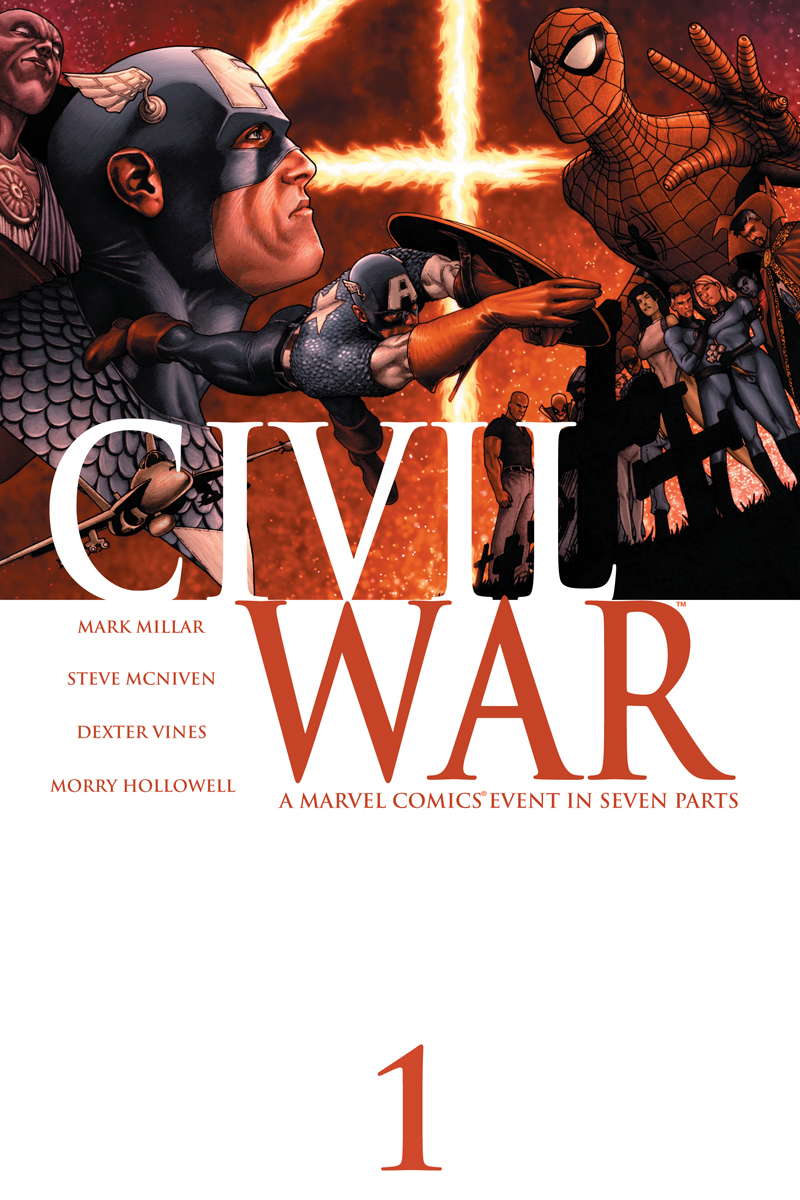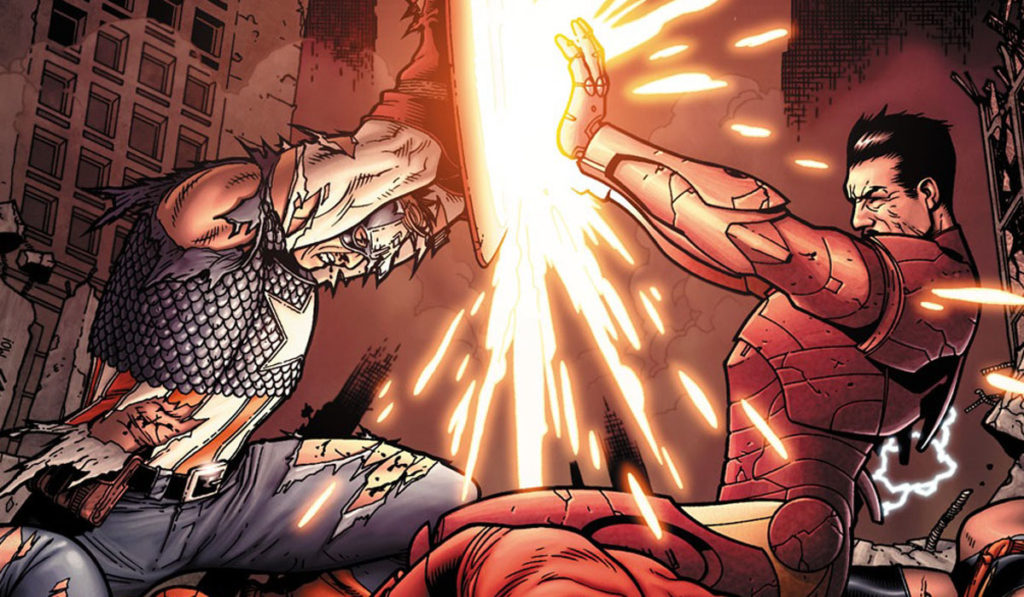
Marvel’s Civil War is a seminal comic book crossover storyline published by Marvel Comics, running through a seven-issue limited series written by Mark Millar and illustrated by Steve McNiven, along with various tie-in books. It fundamentally reshaped the Marvel Universe, pitting heroes against each other over the Superhuman Registration Act (SRA). Below is a detailed synopsis of the series, issue by issue, providing an in-depth look at the plot and its developments.
Issue #1

The series kicks off with a tragic event in Stamford, Connecticut, where the New Warriors, a group of young superheroes filming a reality TV show, attempt to apprehend several supervillains. During the battle, Nitro, one of the villains, detonates himself, causing a massive explosion that kills over 600 people, including many children at a nearby elementary school. The nation is horrified, and public outcry for regulation of superheroes grows.
In response to the tragedy, the U.S. government proposes the Superhuman Registration Act (SRA), which requires all individuals with superpowers to register with the government, reveal their identities, and work under official supervision. This legislative move divides the superhero community. Tony Stark (Iron Man) supports the act, believing it will ensure accountability and prevent further disasters. Conversely, Steve Rogers (Captain America) opposes the act, arguing it infringes on personal freedoms and the right to privacy.
Captain America refuses to comply with the SRA and goes underground, leading a resistance movement against the government’s mandate. The issue concludes with the stark reality of the coming conflict: heroes will be pitted against heroes in a battle over principles and control.
Issue #2

The divide among superheroes deepens as the Superhuman Registration Act becomes law. Tony Stark, Reed Richards (Mr. Fantastic), and Hank Pym (Yellowjacket) publicly support the SRA and begin recruiting heroes to their cause. Stark works to gain public favor by convincing Spider-Man to reveal his secret identity as Peter Parker during a press conference, a significant and shocking moment that sways public opinion.
Meanwhile, Captain America forms an underground resistance group known as the Secret Avengers, including heroes who oppose the SRA on moral grounds. They work covertly to protect unregistered superhumans and thwart the efforts of the pro-registration faction. The conflict escalates when S.H.I.E.L.D., now tasked with enforcing the SRA, actively hunts down unregistered heroes.
The issue underscores the growing tension and the moral complexity of the situation, highlighting the personal and ideological struggles faced by both sides.
Issue #3

The conflict reaches a boiling point as Iron Man and his team set a trap for Captain America’s Secret Avengers. During a confrontation at a chemical plant, both sides clash violently. The pro-registration side, now including Spider-Man and the Thunderbolts, a team of reformed supervillains, aims to capture the anti-registration heroes.
The battle is fierce, showcasing the deep divisions and the intense stakes. However, it takes a tragic turn when Goliath (Bill Foster) is killed by a clone of Thor, created by Mr. Fantastic and Tony Stark to bolster their ranks. This shocking event highlights the ethical breaches and the desperate measures taken by the pro-registration side.
In the aftermath, the death of Goliath has a profound impact on both factions. Some heroes, including Sue Storm (Invisible Woman), switch sides, joining Captain America’s resistance, disillusioned by the extreme tactics used by their former allies.
Issue #4

As the conflict intensifies, both sides work to gain strategic advantages. Captain America’s Secret Avengers continue their guerrilla warfare tactics, while Iron Man’s team implements stricter enforcement measures, capturing more unregistered heroes. The captured heroes are imprisoned in the Negative Zone, a stark and controversial move that raises ethical questions.
The strain of the conflict affects relationships and alliances. Spider-Man, struggling with the moral implications of his decisions, begins to doubt his alignment with Iron Man. The public, initially supportive of the SRA, starts to question the heavy-handed methods used to enforce it.
Reed Richards, a key architect of the SRA, faces personal turmoil as his wife, Sue Storm, leaves him due to their opposing views on the act. The issue delves into the personal costs of the civil war, showcasing the deep emotional and psychological toll on the heroes involved.
Issue #5

The story delves deeper into the personal conflicts and moral dilemmas faced by the characters. Spider-Man, now fully disillusioned with the pro-registration side, decides to defect. He publicly denounces the SRA and is immediately targeted by Iron Man and his allies. Spider-Man’s defection marks a significant turning point, as he narrowly escapes capture with the help of the Secret Avengers.
Meanwhile, the pro-registration side continues to implement their strategies, now employing the Thunderbolts more aggressively to hunt down unregistered heroes. The ethical implications of using former villains as enforcers become more pronounced, highlighting the moral grey areas of the conflict.
The issue also explores the role of the media and public perception, as both sides attempt to sway public opinion through various means. The narrative showcases the complexity of the civil war, where the line between right and wrong becomes increasingly blurred.
Issue #6

The penultimate issue ramps up the action and the stakes. Both sides prepare for a final confrontation. Captain America’s Secret Avengers, bolstered by new recruits and allies, plan a daring raid to free the imprisoned heroes in the Negative Zone. The raid is meticulously planned, showcasing the strategic brilliance of Captain America and his team.
The battle is intense, with both sides suffering casualties and significant injuries. The conflict is not just physical but also deeply ideological, as characters confront their former friends and allies. The issue highlights the tragic nature of the civil war, where no side emerges unscathed.
In a climactic moment, Captain America and Iron Man engage in a brutal one-on-one battle, symbolizing the deep personal and ideological divide between them. The issue ends on a cliffhanger, setting the stage for the final resolution of the conflict.
Issue #7

The final issue brings the civil war to its dramatic conclusion. The battle between the pro-registration and anti-registration forces continues in the streets of New York, causing widespread destruction and chaos. As the conflict reaches its peak, Captain America gains the upper hand in his fight against Iron Man.
However, amidst the chaos and the civilian casualties, Captain America has a moment of clarity. Realizing the extent of the destruction and the toll on innocent lives, he orders his team to stand down. Captain America, recognizing that their battle is causing more harm than good, surrenders to the authorities.
The issue concludes with Captain America being taken into custody, a poignant and powerful moment that underscores the cost of the civil war. The Superhuman Registration Act remains in effect, but the conflict has left deep scars on the superhero community. The series ends with a somber reflection on the nature of heroism, freedom, and responsibility.
Marvel’s Civil War is a complex and multifaceted storyline that explores the ethical and moral dilemmas faced by superheroes. The series delves into themes of freedom versus security, personal liberty versus public safety, and the ethical implications of power. Through its detailed narrative and character-driven plot, the story provides a thought-provoking look at the consequences of conflict and the nature of heroism. The impact of the civil war continues to resonate in the Marvel Universe, influencing numerous characters and storylines in its aftermath.




